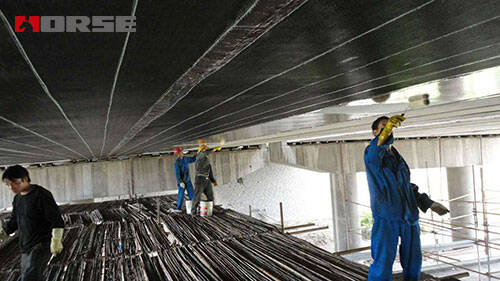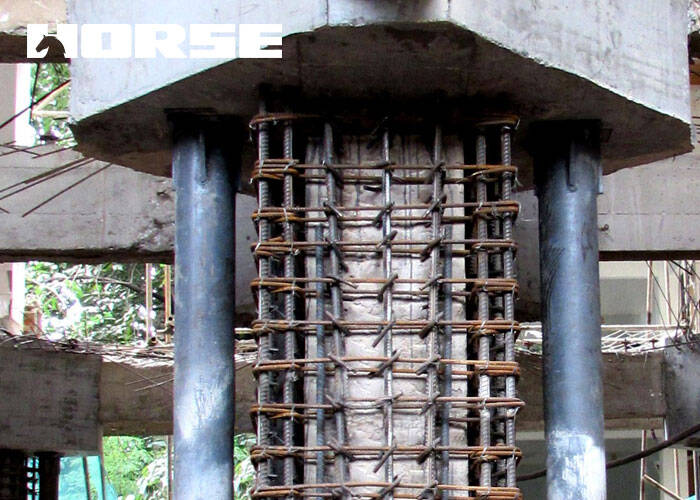Solutions
Horse Construction offers full range of structural strengthening materials with technical supports, documentation supports, products supports, project supports.
bridge reinforcement methods
Vehicle overloading and lack of maintenance have caused various diseases on the bridge, posing a great threat to its normal use, and at the same time bringing huge hidden dangers to the safety of people's lives and property. In order to ensure the safety of bridge use, it is urgent to strengthen and reform the disease, improve its overall performance, ensure its normal service within a reasonable life span, and maximize its role as a transportation link.
The importance of bridge reinforcement
Improve the safety performance of the bridge
Save construction cost
Conducive to safeguarding people’s personal and property safety
Promote sustainable and harmonious development
Bridge reinforcement methods, their characteristics and applicability

Carbon fiber structural reinforcement method
Carbon fiber is commonly used in bridge reinforcement of concrete structures in recent years. The reinforcement method is based on the structural principle of concrete, that is, the good coordination between steel and concrete, and the superiority of steel in elastic modulus and tensile strength. The method of pasting carbon fiber is to use the high strength of carbon fiber and the similar modulus of elasticity to coat the bonding resin on the concrete to combine the carbon fiber with the concrete and improve the strength of the concrete. When the carbon fiber cloth is pasted, it should be rolled and compacted with a rubber roller several times in the direction of its force to drive out the air bubbles to ensure that the carbon fiber cloth is pasted tightly and tightly integrated with the concrete surface. After the first layer of carbon fiber cloth is pasted, the second layer of adhesive should be applied in time. After the adhesive has cured to a certain degree, the second layer of carbon fiber cloth should be pasted. Repeat the above steps until the number of layers reaches the number required by the design. The ends of carbon fibers are usually difficult to fix, and can be treated with steel plate fixation. After the carbon fiber cloth is pasted, it is necessary to apply a layer of rubber to the outermost layer to form a surface protection layer. The protective layer can be prepared by adding a small amount of talcum powder to the bonding compound, and after the compound is cured, an inorganic material is used for surface coating.
The carbon fiber reinforcement method can be used for bending and shear reinforcement of concrete structures. It is also widely used in bridges of various structures, such as the most common reinforcement of concrete structures, wood or steel structures. After the use of carbon fiber materials for reinforcement, the load-bearing capacity, earthquake resistance and corrosion resistance of the bridge have been significantly improved.
Prestressed reinforcement method
Pre-stressed steel bars are added outside the original member, and the internal force distribution of the original structure is changed by applying pre-stress to it to achieve the purpose of improving the bearing capacity of the structure. The additional pre-stressed rods and braces have good co-working performance with the original structure, and their bearing capacity has been improved relatively greatly. Prestressed reinforcement construction technology has many characteristics, such as low construction difficulty, does not affect the bridge structure itself, and the construction process is relatively simple. In bridge construction, the external prestressed reinforcement method is mainly used to strengthen the structure of beam bridges including continuous system beams, cantilever beams, and simply supported beam bridges when their normal service limit states are exceeded. In addition, large-span structures and large-scale structural reinforcements under higher stress and strain conditions that cannot be reinforced by general methods or the reinforcement effect is not ideal. By strengthening the built bridge by external prestressing, not only can the purpose of reducing or eliminating cracks be achieved, but compared with other strengthening methods, it also helps to reduce the cross-sectional size and self-weight of the beam body and improve the service life of the bridge structure.

Enlarged member section reinforcement method
The method of increasing the component section refers to the method of strengthening the bridge by increasing the section area of steel or concrete. The method of adding steel bars needs to be processed on the concrete protective layer, and then the new and old main steel bars are connected by welding, the long stirrups, and the concrete protective layer is restored to achieve reinforcement.Reinforcement with enlarged section method has the following characteristics:
1) The main materials used in modern bridges are concrete, steel bars and planting glue. The materials are low in cost and easy to obtain, simple in construction, relatively low in technology, and economical and effective. Compared with other reinforcement methods, the construction quality is the easiest to control;
2) In the design, the force of the main beam is clear and the calculation is simple, which reduces the workload of design calculation and speeds up the design cycle;
3) Enlarged section method requires a large amount of wet work in the reinforcement construction, which can be combined with the bridge deck to be reconstructed to improve the lateral force transmission of the bridge and increase the overall rigidity and stability of the bridge. In actual engineering, this technology has a wide range of applications in arch bridges, continuous bridges, double-curved arch bridges, bending members, fire-damaged bridges, and abutment reinforcement.
Bridge reinforcement is an important subject in the field of engineering research and an inevitable requirement of the development of the times. We must focus on the overall situation, fully analyze the pros and cons, and adopt the most scientific reinforcement technical solutions and processes. At the same time, the basic theoretical research is closely integrated with scientific and technological progress, and constantly summarized, and innovative. In addition, for units related to bridge reinforcement, a scientific and complete construction plan and measures must be formulated to ensure the safety and reliability of the construction and ensure the quality of the construction. At the same time, post-evaluation should be carried out to strengthen the bridge, establish a file card, summarize the gains and losses, and analyze the advantages and disadvantages of the technology, materials, and processes and the effects of use. To enrich our country's bridge strengthening experience database, and strive to make new and greater contributions to the development of our country's bridge industry.
You can find anything here you are in need of, have a trust trying on these products, you will find the big difference after that.

High strength carbon fiber reinforced polymer (CFRP) strip / laminate / plate for structural strengthening and concrete repair

High strength, unidirectional carbon fiber sheet pre-saturated to form a carbon fiber reinforced polymer (CFRP) sheet used to strengthen structural concrete elements.

Two-components modified epoxy resin adhesive, with high quality plastic tube, double cartridge package for anchoring